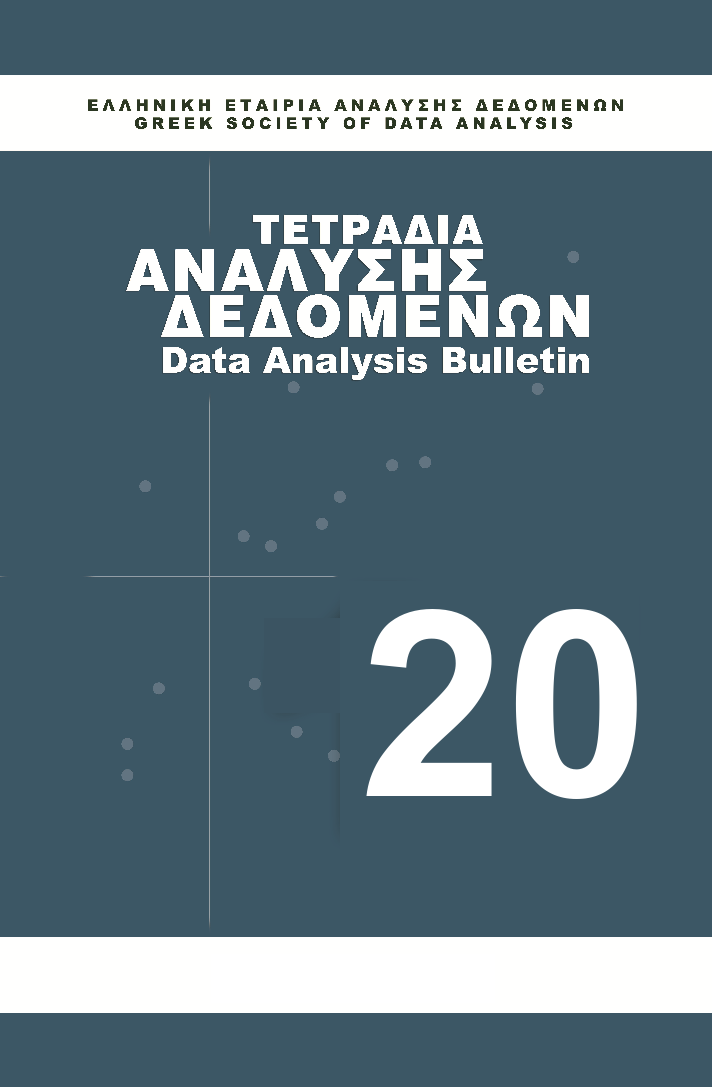Το <<ερμηνευτικό επίπεδο>> στην ερμηνεία του παραγοντικού επιπέδου με συμπληρωματικές μεταβλητές: Εφαρμογή στην Αναλυτική χρηματοοικονομικών δεδομένων

Περίληψη
Η παραγοντική μέθοδος των πολλαπλών αντιστοιχιών (ΜCA) είναι μέθοδος της μη επιβλεπόμενης μηχανικής μάθησης που εφαρμόζεται σε κατηγορικής φύσεως δεδομένα προκειμένου να διερευνηθούν οι εντονότερες αλληλοεπιδράσεις μεταξύ των κατηγοριών τους, καθώς και οι κατευθύνσεις(τάσεις) της διασποράς τους. Οι συμπληρωματικές μεταβλητές που χρησιμοποιούνται και στην (ΜCA) δεν συμμετέχουν στην κατασκευή των παραγοντικών αξόνων, απλώς προβάλλονται μέσω των σχέσεων μεταφοράς μαζί με τα υπόλοιπα σημεία (κατηγορίες μεταβλητών) στα παραγοντικά διαγράμματα και μπορούν να συμβάλουν περαιτέρω στην ερμηνεία του φαινομένου. Στην παρούσα εργασία εξετάζεται ο τρόπος με τον οποίο μπορεί να ενσωματωθεί η γραφική πληροφορία από το «Ερμηνευτικό Επίπεδο» στα παραγοντικά επίπεδα που περιλαμβάνουν συμπληρωματικά σημεία. Μέσω του Ερμηνευτικού Επιπέδου εντοπίζονται τα σημαντικά ερμηνευτικά σημεία του παραγοντικού επιπέδου και στη συνέχεια εκείνα από αυτά που είναι τα «κοντινά» σε συμπληρωματικά σημεία. Έτσι οι χρήστες που επιθυμούν να χρησιμοποιήσουν συμπληρωματικές μεταβλητές στις αναλύσεις τους μπορούν να πετύχουν καλύτερα και ασφαλέστερα ερμηνευτικά αποτελέσματα-συμπεράσματα. Τα ως άνω εφαρμόστηκαν στη διερεύνηση του συστήματος ανταμοιβών, στην επίδοση, ανάπτυξη και αποτελεσματικότητα των επιχειρήσεων. Οι μεταβλητές τομέας επιχείρησης και η ιεραρχική θέση των εργαζομένων στην επιχείρηση ελήφθησαν ως συμπληρωματικές.
Λεπτομέρειες άρθρου
- Πώς να δημιουργήσετε Αναφορές
-
Μοσχίδης Σ., & Θανόπουλος Α. Κ. (2024). Το <<ερμηνευτικό επίπεδο>> στην ερμηνεία του παραγοντικού επιπέδου με συμπληρωματικές μεταβλητές: Εφαρμογή στην Αναλυτική χρηματοοικονομικών δεδομένων . Τετράδια Ανάλυσης Δεδομένων, 20(1), 24–31. ανακτήθηκε από https://ejournals.epublishing.ekt.gr/index.php/dab/article/view/32333
- Ενότητα
- Εμπειρικές μελέτες

Αυτή η εργασία είναι αδειοδοτημένη υπό το CC Αναφορά Δημιουργού – Μη Εμπορική Χρήση – Όχι Παράγωγα Έργα 4.0 4.0.
Οι Συγγραφείς που δημοσιεύουν εργασίες τους στο περιοδικό ΤΕΤΡΑΔΙΑ ΑΝΑΛΥΣΗΣ ΔΕΔΟΜΕΝΩΝ συμφωνούν στους παρακάτω όρους:
- Οι Συγγραφείς δεν χρεώνονται με έξοδα υποβολής, επεξεργασίας ή δημοσίευσης των εργασιών τους. Τα κόστη αυτά καλύπτονται από την Ελληνική Εταιρία Ανάλυσης Δεδομένων.
- Τα πνευματικά δικαιώματα των εργασιών που δημοσιεύονται στο περιοδικό ΤΕΤΡΑΔΙΑ ΑΝΑΛΥΣΗΣ ΔΕΔΟΜΕΝΩΝ προστατεύονται από την άδεια Creative Commons Attribution-NonCommercial-ΝοDerivatives 4.0 International. Οι Συγγραφείς διατηρούν τα Πνευματικά Δικαιώματα και χορηγούν στο περιοδικό το δικαίωμα της πρώτης δημοσίευσης. Η άδεια αυτή επιτρέπει σε τρίτους - αποδέκτες της άδειας να χρησιμοποιούν την εργασία σε οποιαδήποτε μορφή μόνο για μη εμπορικούς σκοπούς. Αν οι τρίτοι τροποποιήσουν ή προσαρμόσουν το περιεχόμενο, οφείλουν να κοινοποιήσουν το τροποποιημένο περιεχόμενο for noncommercial purposes only. If others modify or adapt the material, they must license the modified material under identical terms.
- Με την προϋπόθεση της διατήρησης των διατυπώσεων που προβλέπονται στην άδεια σχετικά με την αναφορά στον αρχικό δημιουργό και την αρχική δημοσίευση στο περιοδικό ΤΕΤΡΑΔΙΑ ΑΝΑΛΥΣΗΣ ΔΕΔΟΜΕΝΩΝ.
- Οι Συγγραφείς μπορούν να συνάπτουν ξεχωριστές και πρόσθετες συμβάσεις και συμφωνίες για τη μη αποκλειστική διανομή της εργασίας όπως δημοσιεύτηκε στο περιοδικό ΤΕΤΡΑΔΙΑ ΑΝΑΛΥΣΗΣ ΔΕΔΟΜΕΝΩΝ (π.χ. κατάθεση σε ακαδημαϊκά καταθετήρια), με την προϋπόθεση της αναγνώρισης και την αναφοράς της πρώτης δημοσίευσης στο περιοδικό ΤΕΤΡΑΔΙΑ ΑΝΑΛΥΣΗΣ ΔΕΔΟΜΕΝΩΝ.
- Το περιοδικό ΤΕΤΡΑΔΙΑ ΑΝΑΛΥΣΗΣ ΔΕΔΟΜΕΝΩΝ Α επιτρέπει και ενθαρρύνει τους συγγραφείς να καταθέτουν τις εργασίες τους σε θεσμικά (π.χ. το αποθετήριο του Εθνικού Κέντρου Τεκμηρίωσης) ή θεματικά αποθετήρια, μετά τη δημοσίευσή τους στο ΤΕΤΡΑΔΙΑ ΑΝΑΛΥΣΗΣ ΔΕΔΟΜΕΝΩΝ και με όρους Ανοικτής Πρόσβασης, όπως κατά περίπτωση προσδιορίζονται από τους χρηματοδότες της έρευνάς τους ή/και τα ιδρύματα με τα οποία συνεργάζονται. Κατά την κατάθεση της εργασίας τους, οι συγγραφείς πρέπει να παρέχουν πληροφορίες σχετικά με τη δημοσίευση της εργασίας στο περιοδικό και τις πηγές χρηματοδότησης της έρευνάς τους. Κατάλογοι των ιδρυματικών και θεματικών αποθετηρίων ανά χώρα υπάρχουν στη βάση http://opendoar.org/countrylist.php. Οι συγγραφείς έχουν τη δυνατότητα να καταθέσουν χωρίς κόστος την εργασία τους στο αποθετήριο www.zenodo.org, το οποίο υποστηρίζεται από το OpenAIRE (www.openaire.eu ), στο πλαίσιο των πολιτικών της Ευρωπαϊκής Επιτροπής για την ενίσχυση της Ανοικτής ακαδημαϊκής έρευνας.


